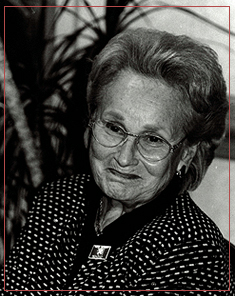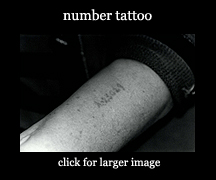Bio of Margit Buchhalter Feldman
 Margit,
the only child of Joseph and Theresa Buchhalter was born in Hungary
on June 12, 1929 in Budapest. Her parents had an orthodox home.
They lived in Tolcsva near the Czechoslovakian border; a small agricultural
town numbering about two thousand people with Jews making up one
tenth of the population. Margit had fond memories of her early childhood
and looked forward to the celebration of holidays and the Sabbath.
Margit attended parochial school that was supported by the government.
There were about sixty Jewish children in her town and they attended
Jewish day-school. As a child, Margit was conscious of the prejudice
against the Jews. Religious children dressed differently and suffered
from discrimination by their non-Jewish peers. In 1941, Margit attended
school in Budapest and lived with her relatives for a while. The
Jews were already suffering from a set of discriminating laws that
were implemented against them in the late 1930’s. Margit was
brought home because her parents feared for her safety. Margit,
the only child of Joseph and Theresa Buchhalter was born in Hungary
on June 12, 1929 in Budapest. Her parents had an orthodox home.
They lived in Tolcsva near the Czechoslovakian border; a small agricultural
town numbering about two thousand people with Jews making up one
tenth of the population. Margit had fond memories of her early childhood
and looked forward to the celebration of holidays and the Sabbath.
Margit attended parochial school that was supported by the government.
There were about sixty Jewish children in her town and they attended
Jewish day-school. As a child, Margit was conscious of the prejudice
against the Jews. Religious children dressed differently and suffered
from discrimination by their non-Jewish peers. In 1941, Margit attended
school in Budapest and lived with her relatives for a while. The
Jews were already suffering from a set of discriminating laws that
were implemented against them in the late 1930’s. Margit was
brought home because her parents feared for her safety.
Margit’s father Joseph owned a general store and suffered
from economic decline because he was forbidden to carry and sell
certain merchandise such as sugar, coffee, flour and various oils.
These products required coupons and Jews were not permitted to sell
them. In the summer of 1943, her father and two uncles were ordered
to report to an assigned location in order to be taken to a forced
labor camp. While her father and uncles were away working on a farm,
her mother Theresa ran the business and Margit helped with many
of the chores. He was released shortly before the German occupation
in March of 1944. The Arrow Cross, an extreme right-wing nationalistic
Hungarian group started their own “Final Solution” of
the Jews before Passover of 1944.
The Buchhalter family and many other Jews were imprisoned in a ghetto
of Satoraljaujhely, a nearby town. From there Margit and her family
were shipped to Auschwitz, a death camp in Poland. In Auschwitz
Margit who was 15 years old lost her protective parents and clung
to her aunts who survived the selections for death. She told the
Nazis that she was eighteen and this made her eligible for forced
labor. She was transferred to Crakow to work in a quarry for a little
while and then sent back to Auschwitz. During her second stay in
Auschwitz she became aware of the terrible experiments on twins
that were being conducted by infamous Dr. Josef Mengele.
 In
early winter of 1944-45 she was shipped to work in a munitions factory
in a camp called Grunberg, a subcamp of Gross Rosen in eastern Germany;
that camp was not as harsh as Auschwitz. Margit and the prisoners
had a little more food to eat. There she met Gerda Weiss Klein,
a well known Holocaust survivor and writer. Margit was taken on
a death march to Bergen Belsen. She was liberated on April 15, 1945
in Bergen Belsen by the British, a very sick young girl of sixteen,
all alone and without family. She was injured by an explosive set
by the Germans intending to destroy the camp and had pleurisy and
pneumonia. In
early winter of 1944-45 she was shipped to work in a munitions factory
in a camp called Grunberg, a subcamp of Gross Rosen in eastern Germany;
that camp was not as harsh as Auschwitz. Margit and the prisoners
had a little more food to eat. There she met Gerda Weiss Klein,
a well known Holocaust survivor and writer. Margit was taken on
a death march to Bergen Belsen. She was liberated on April 15, 1945
in Bergen Belsen by the British, a very sick young girl of sixteen,
all alone and without family. She was injured by an explosive set
by the Germans intending to destroy the camp and had pleurisy and
pneumonia.
Margit was fortunate to be sent to Sweden to recover after the war
and received kind treatment by the Swedish people. She found out
that she had an aunt and uncle in the United States and joined them
in August of 1947.
When Margit came to the United States she was still sick and it
took her a number of years to recover. After she recovered she became
an x-ray technician. This is when she met her Harvey Feldman, they
were married in 1953 and have two children Tina and Joseph and three
grandchildren, Caryn, Joshua and Zachary.
Margit has devoted her adult life to teaching children about the
Holocaust and doing community work. She has dedicated herself to
helping the powerless and vulnerable. The book: Margit- A
Teenager’s Journey through the Holocaust and Beyond
written by her and Bernard Weinstein has become recommended reading
for children studying the Holocaust and distributed by the State
of New Jersey Commission on Holocaust Education. Margit is a staunch
supporter of Raritan Valley Community College Institute for Holocaust
and Genocide Studies, and helps to create an annual spring program
which three-thousand students attend each year to learn about the
Holocaust and Genocide.
SUGGESTED RESOURCES
Holliday, Laurel ed Children of the Holocaust and World War
II and Their Diaries-Grades 7-12 Covering all the countries
that were involved during WWII
Atkinson, Linda- In Kindling Flame: Story of Hannah Senesh-
Grade 7-12- Telling of young Jewish Heroine who tried to help Hungarian
Jews
Bierman, John-Righteous Gentiles: Story of Raoul Wallenberg,
Missing Hero of the Holocaust- Grade 9-12 Detailed account
how he saved thousand of Jews by issuing them Swedish passports.
Bitton-Jackson, Livia- Elli: Coming of Age in the Holocaust
Grade 9-12- Tells story how she miraculously survived the war as
a teenager
Bitton-Jackson, Livia- I have lived a Thousand Years: Growing
Up In the Holocaust- Grade 5-10 A younger adaptation of
the above book
Isaacson, Judith Magyar-The Seed of Sarah: Memoirs of a Survivor
Grade 10-12 Joyful life in Hungary and then Auschwitz
Block, Gay and Malka Drucker- Rescuers: Portrait of Moral
Courage in the Holocaust Grade 9-12 Forty nine people in
many countries risked their lives to save Jews.
INTERNET SITES
Council of Holocaust Educators
www.che-nj.org
great
site for Educators
http://fcit.coedu.usf.edu/Holocaust/people/children
United
States Holocaust Museum, Washington, DC
http:www.ushmm.org
|
 Margit,
the only child of Joseph and Theresa Buchhalter was born in Hungary
on June 12, 1929 in Budapest. Her parents had an orthodox home.
They lived in Tolcsva near the Czechoslovakian border; a small agricultural
town numbering about two thousand people with Jews making up one
tenth of the population. Margit had fond memories of her early childhood
and looked forward to the celebration of holidays and the Sabbath.
Margit attended parochial school that was supported by the government.
There were about sixty Jewish children in her town and they attended
Jewish day-school. As a child, Margit was conscious of the prejudice
against the Jews. Religious children dressed differently and suffered
from discrimination by their non-Jewish peers. In 1941, Margit attended
school in Budapest and lived with her relatives for a while. The
Jews were already suffering from a set of discriminating laws that
were implemented against them in the late 1930’s. Margit was
brought home because her parents feared for her safety.
Margit,
the only child of Joseph and Theresa Buchhalter was born in Hungary
on June 12, 1929 in Budapest. Her parents had an orthodox home.
They lived in Tolcsva near the Czechoslovakian border; a small agricultural
town numbering about two thousand people with Jews making up one
tenth of the population. Margit had fond memories of her early childhood
and looked forward to the celebration of holidays and the Sabbath.
Margit attended parochial school that was supported by the government.
There were about sixty Jewish children in her town and they attended
Jewish day-school. As a child, Margit was conscious of the prejudice
against the Jews. Religious children dressed differently and suffered
from discrimination by their non-Jewish peers. In 1941, Margit attended
school in Budapest and lived with her relatives for a while. The
Jews were already suffering from a set of discriminating laws that
were implemented against them in the late 1930’s. Margit was
brought home because her parents feared for her safety.